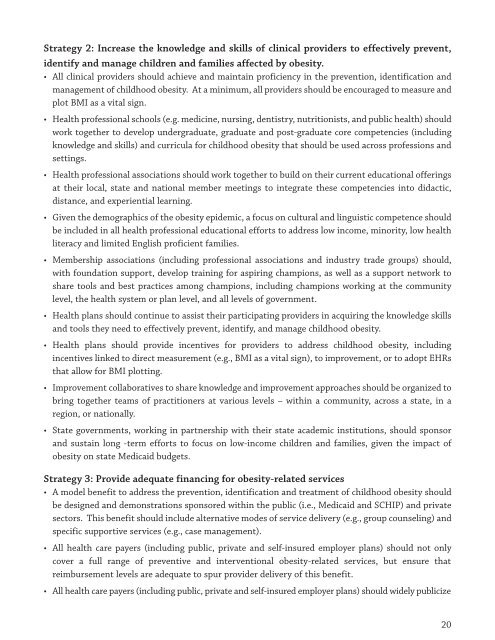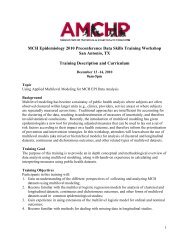Childhood Obesity: The Role of Health Policy - Association of ...
Childhood Obesity: The Role of Health Policy - Association of ...
Childhood Obesity: The Role of Health Policy - Association of ...
Create successful ePaper yourself
Turn your PDF publications into a flip-book with our unique Google optimized e-Paper software.
Strategy 2: Increase the knowledge and skills <strong>of</strong> clinical providers to effectively prevent,<br />
identify and manage children and families affected by obesity.<br />
• All clinical providers should achieve and maintain pr<strong>of</strong>iciency in the prevention, identification and<br />
management <strong>of</strong> childhood obesity. At a minimum, all providers should be encouraged to measure and<br />
plot BMI as a vital sign.<br />
• <strong>Health</strong> pr<strong>of</strong>essional schools (e.g. medicine, nursing, dentistry, nutritionists, and public health) should<br />
work together to develop undergraduate, graduate and post-graduate core competencies (including<br />
knowledge and skills) and curricula for childhood obesity that should be used across pr<strong>of</strong>essions and<br />
settings.<br />
• <strong>Health</strong> pr<strong>of</strong>essional associations should work together to build on their current educational <strong>of</strong>ferings<br />
at their local, state and national member meetings to integrate these competencies into didactic,<br />
distance, and experiential learning.<br />
• Given the demographics <strong>of</strong> the obesity epidemic, a focus on cultural and linguistic competence should<br />
be included in all health pr<strong>of</strong>essional educational efforts to address low income, minority, low health<br />
literacy and limited English pr<strong>of</strong>icient families.<br />
• Membership associations (including pr<strong>of</strong>essional associations and industry trade groups) should,<br />
with foundation support, develop training for aspiring champions, as well as a support network to<br />
share tools and best practices among champions, including champions working at the community<br />
level, the health system or plan level, and all levels <strong>of</strong> government.<br />
• <strong>Health</strong> plans should continue to assist their participating providers in acquiring the knowledge skills<br />
and tools they need to effectively prevent, identify, and manage childhood obesity.<br />
• <strong>Health</strong> plans should provide incentives for providers to address childhood obesity, including<br />
incentives linked to direct measurement (e.g., BMI as a vital sign), to improvement, or to adopt EHRs<br />
that allow for BMI plotting.<br />
• Improvement collaboratives to share knowledge and improvement approaches should be organized to<br />
bring together teams <strong>of</strong> practitioners at various levels – within a community, across a state, in a<br />
region, or nationally.<br />
• State governments, working in partnership with their state academic institutions, should sponsor<br />
and sustain long -term efforts to focus on low-income children and families, given the impact <strong>of</strong><br />
obesity on state Medicaid budgets.<br />
Strategy 3: Provide adequate financing for obesity-related services<br />
• A model benefit to address the prevention, identification and treatment <strong>of</strong> childhood obesity should<br />
be designed and demonstrations sponsored within the public (i.e., Medicaid and SCHIP) and private<br />
sectors. This benefit should include alternative modes <strong>of</strong> service delivery (e.g., group counseling) and<br />
specific supportive services (e.g., case management).<br />
• All health care payers (including public, private and self-insured employer plans) should not only<br />
cover a full range <strong>of</strong> preventive and interventional obesity-related services, but ensure that<br />
reimbursement levels are adequate to spur provider delivery <strong>of</strong> this benefit.<br />
• All health care payers (including public, private and self-insured employer plans) should widely publicize<br />
20



